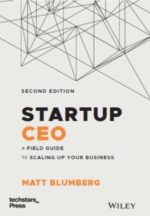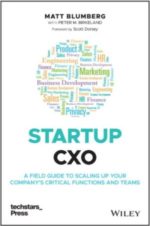Big Apple, Little Company
Big Apple, Little Company
Ed Daciuk, on of my blog subscribers, questions: What is your view on the benefits of being in NYC as a startup?
Fred wrote a good posting several months ago and a related one this week on early stage investing in the NYC market from the perspective of a venture capitalist. His main points: (1) NYC is a great place to invest in early stage tech-related businesses as long as they’re not "core technology" businesses like semiconductor or hardware, because (2) core technology companies are more exciting to investors, and therefore the investors have clustered around those companies in places like Silicon Valley or Boston. He also thinks this dynamic is changing as more and more successful companies are started as technology-enabled service businesses as opposed to pure tech companies.
As someone who’s been in tech-enabled services businesses in NYC for 10 years now, I couldn’t agree more with this last point. But I thought I’d address Ed’s question from the entrepreneur’s perspective as well.
First, why is New York a great place for a startup?
1. Access to customers. There is far greater concentration of major corporations and agencies headquartered in and around the NYC area, making it much easier to see and talk to prospects and customers in this market.
2. Lots of talent. There are lots of people, meaning there are lots of people to hire. Some disciplines are easier than others to find talent, but the labor pool is just huge.
3. Convenience. This is always one of NYC’s main selling points, and it applies here as well. It’s mainly a collection of little things like being able to see a customer or investor in minutes by foot or mass transit and late night food delivery, but all those extra minutes you save here and there add up!
4. Idea generation. The density and complexity of the city’s business landscape make it a natural for stimulating great ideas, especially in the service and media sectors.
5. Work ethic. New Yorkers are accustomed to working startup hours in many professions — banking, consulting, law, etc., so it’s much more natural to have a team pounding away at the office early and late than it is in other geographies.
But it’s not all that easy. New York can also be a difficult place for a startup because:
1. It’s expensive. Very expensive. People cost more, benefits cost more, T&E costs more, rent costs more.
2. Space is limited. There’s no such thing as starting out in someone’s garage, because there are no garages — only teeny tiny apartments. And no one takes a lease with room to grow because that extra space comes at such a premium.
3. Good money is harder to find. As Fred says, it’s getting better, but the environment still isn’t as rich with high quality VCs as places like Silicon Valley or Boston.
4. Even when you do find good money, valuations are tougher. For whatever reason, I’ve always found that "west coast" valuations are more generous than "east coast" valuations.
On balance, I’d say it’s probably a wash — there are plusses and minuses of NYC as a place for startups. But it’s definitely not, as conventional wisdom would have it, an inhospitable environment for startups.
Book Short: Great Marketing Checklists
Book Short: Great Marketing Checklists
Trade Show and Event Marketing: Plan, Promote, and Profit, by our direct marketing colleague Ruth Stevens, is hardly a page-turner, but it is a great read and well worth the money for anyone in your B2B marketing department. That’s true as much for the event marketing specialist as the marketing generalist.
The author brings a very ROI-focused approach to planning and executing events – whether big trade shows or smaller corporate events, which are becoming increasingly popular in recent years for cost, focus, and control reasons. But beyond events, the book has a number of excellent checklists that are more general for marketers that I found quite useful both as a reminder of things we should be doing at Return Path as well as ways we should be thinking about the different elements of our B2B marketing mix.
Some of the best tables and charts include: strengths, weaknesses, and best applications of trade shows vs. corporate events; comparative analysis of marketing tools by channel (this was great – talks about best applications for all major tools from events to newsletters to search to inside sales); 12-month exhibitor timeline for trade shows; a great riff on bad booth signage vs. good booth signage (hint: don’t make the visitor do the work – be obvious!); business event strategic planning grid; pre-show campaign and post-show follow-up checklists; dos, don’ts and options for corporate events; a great section on qualifying and handling leads that extends well beyond trade shows; and several good case studies that are show-focused.
Thanks to Ruth herself for an autographed copy! Team Marketing and sales leaders at Return Path – your copies are on the way.
The Business of Being a Scumbag, Part II
The Business of Being a Scumbag, Part II
From today’s Direct Newsline email newsletter (no apparent way to link to it) comes another view into how the Internet Axis of Evil carries out its mission.
Zombie Computer Network Commits Click Fraud
A global network of 34,000 “zombie” computers infected with a Trojan Horse virus is being used to commit click fraud against pay-per-click (PPC) advertisers, according to software security research firm PandaLabs.
It is thought to be the largest click-fraud bot network detected so far, and comes at a time when advertisers are reported to be growing increasingly worried about wasting their performance-ad dollars on unqualified clicks.
The firm reported Friday that, according to data it has observed, the computers are infected with the Clickbot.A bot and controlled remotely through several Web servers. This allows the fraudsters to define the Web pages on which the ads are hosted and set the maximum number of clicks from a single IP address, in order to elude detection software. The system can also evade fraud detection by sending click requests from different unrelated IP addresses.
“Renting and selling of botnets has become a genuine business model for cyber crooks,” explained PandaLabs director Luis Corrons, in a statement. “The scam we have now uncovered exploits infected systems to generate profits through ‘par-per-click systems, instead of by installing spyware sending spam.”
This is how it works. It’s the same whether you’re talking about spam, viruses, click fraud, phishing, or survey fraud.
Agile Reading
Agile Reading
While not exactly a laugh a minute, Lean Software Development: An Agile Toolkit, by Mary and Tom Poppendieck, is a good read for anyone who is a practitioner of agile development — or anything agile. (Note: if you want a laugh a minute, read Who Moved My Blackberry?, which as Brad says, is hilarious — kind of like The Office in book form).
As I wrote about here and here, Return Path now does both agile development and agile marketing. The book draws many interesting comparisons between manufacturing and engineering, which I found quite interesting, and not just because I’m a former management consultant — there’s something that’s just easier to visualize about how an assembly line works than about how code is written. The foundation of the book is writings and sidebar anecdotes about 22 Tools, all of which are helpful to understand the principles which underly and power a successful agile process.
Concepts such as seeing and eliminating waste, empowering a team while still managing to lead it, and why small-batch work and application of the theory of constraints makes sense across the board are made easy to understand and easy to apply by the authors.
Thanks to my colleague Ed Taussig for this book.
To My Email Subscribers
To My Email Subscribers
Just a quick note to let you know that for now, I’ve switched email engines, so the updates from my blog will come to you from Feedburner instead of Feedblitz. I like Feedblitz and think that its CEO, Phil Hollows, has done a very good job with the service. My switch to Feedburner is about testing out the consolidation between RSS delivery, ad insertion, and email delivery.
So, you shouldn’t notice too much of a difference — the posts will still be emailed to you daily — but the format and "from" address will be slightly different.
All feedback is welcome.
Sticking it to United, Just a Little Bit
Sticking it to United, Just a Little Bit
I am sitting in the Red Carpet Club waiting for yet another delayed United flight, and there’s a small thing bringing me a little extra joy. I recently started using Verizon’s Broadband Wireless service, which is expensive at $60/month, but awesome since it basically works anywhere and eliminates the need for hotel, Starbucks, and other Wi Fi hot spot fees (and for a great tutorial on how to use the service to power two computers at once, read Brad’s post here).
I’ve long been annoyed at United — and American as well — for both charging a pretty sizeable annual fee to belong to their airport clubs and then soaking me for another $10 every time I’m in one just to use their T-Mobile hot spot. Many people, including Fred here, believe that Wi Fi should be free everywhere. While I think that’s a great idea, I don’t think it’s a god-given right. And I don’t mind that Starbucks charges me to use their hot spots, since I may only be spending a couple dollars with them. However, airline clubs that charge a lot of money for membership should definitely include WI Fi as part of the deal.
So my great joy today was *not* giving yet another $10 to United for the privilege of using the Internet. Thank you, Verizon (not that I don’t also have various complaints about Verizon, but that’s for another day).
It truly is the little things…
The Business of Being a Scumbag
The Business of Being a Scumbag
I’ve written a couple of times about what Fred calls the Internet’s Axis of Evil. But David Kirkpatrick from Fortune just blew me away yesterday with his lurid description of the Internet’s crime scene. This is a must-read for anyone who works in the online medium.
Blogiversary, Part II
Blogiversary, Part II
So it’s now been two years since I launched OnlyOnce. Last year at this time, I gave a bunch of stats of how my blog was going.
The interesting thing about this year, is that a lot of these stats seem to have leveled off. I have almost the same number of subscribers (email and RSS) and unique visits as last year. The number’s not bad — it’s in the thousands — and I’m still happy to be writing the blog for all the reasons I expressed here back in June 2004, but it’s interesting that new subs seem to be harder to come by these days. I assume that’s a general trend that lots of bloggers are seeing as the world of user-generated content gets more and more crowded.
Not that I’m competitive with my board members, but I believe that Brad and Fred have both continued to see massive subscriber increases in their blogs. They attribute it to two things — (1) they have lots of money they give to entrepreneurs, and (2) they write a lot more than I do, usually multiple postings per day, as compared to a couple postings per week.
I don’t see either of those aspects of my blog changing any time soon, so if those are the root causes, then I’ll look forward to continuing this for my existing readers (and a few more here and there) into 2007!
links for 2006-05-10
-
Amazon, Microsoft, and Google on big marketing spend
So, Where’d They Go?
So, Where’d They Go?
As we’ve reported a couple times in the past, one of our interesting nuggets at Return Path is a wealth of “ISP switching data” that comes from our very large, active, self-reported Email Change of Address, or ECOA, service (consumer sign-up; client info).
I noted the article floating around last week that AOL lost about 1 million subscribers last quarter, the lion’s share in the U.S., of course.
So, where’d they all go?
Well, according to our ECOA data, which may of course be somewhat skewed by our data sources (but has data from well over 1 million consumers each quarter), AOL users defected as follows:
To Yahoo! — 42.5%
To broadband providers in aggregate (cable, etc.)– 23.5%
To Hotmail/MSN — 19.5%
To Gmail — 2.7%
Thanks to my colleague Iffat Ahmed for help pulling these numbers together.
Counter Cliché: And Founders, Too
Counter Cliché: And Founders, Too
This week, Fred’s chiche is that "the success of a company is in inverse proportion to the number of venture capitalists on the board".
I’d argue that the same statement is true of founders or management.
Boards help govern the company and watch out for shareholder interests. Boards give outside perspectives and strategic advice to the company’s leadership. Boards hire and fire the CEO. And — more and more every day with large public companies — boards keep management honest. How can these critical functions occur when a Board has too many members of the management team on it? They can’t. We’ve had outside directors at Return Path from Day 1.
I’m not advocating that Boards meet 100% apart from senior management. On the contrary, our most productive Board meetings at Return Path are the ones where we have lots of management participation. But execs present and discuss — and don’t vote — and they generally leave the last 30-60 minutes of every meeting for just the Board to discuss issues in private. I’m also not advocating that CEOs don’t sit on boards or that the CEO never hold the Chairman role. I think both of those items are critical to unify the watchdog function of looking out for all company stakeholders — shareholders, employees, and customers — at the highest level.
But while the success of a company may well be in inverse proportion to the number of venture capitalists on the board, that same success is jeopardized by too many execs, too.



